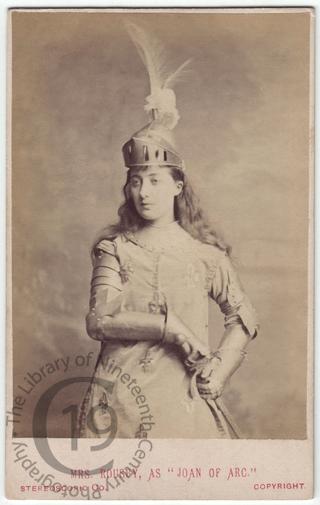
Mrs Rousby as 'Joan of Arc'
A carte-de-visite portrait of the actress Clara Rousby, seen here in Joan of Arc by Tom Taylor, which finally opened at the Queen's Theatre in London on 10 April 1871. The production was a long time coming and was much written about long before its opening night.
'Mr Tom Taylor's "Joan of Arc," which was originally written for Miss Neilson, will be the next production at the Queen's, Mrs Rousby, of course, filling the part of the heroine' (The Globe, 13 July 1870).
'I hear that, upon the termination of their provincial tour, Mr and Mrs Rousby will re-appear at the Queen's Theatre in an historical drama by Mr Tom Taylor founded on the life of Joan of Arc. Mrs Rousby will, of course, be the heroine, and the contrast between the russet gown of the first act to the armour of glittering gold she will afterwards wear will be effective indeed. I need not say how charming Mrs Rousby will appear in either costume. The drama will allow, and indeed demand, great spectacular effects, and will introduce several most picturesque scenes' (Sheffield Daily Telegraph, 1 October 1870).
After one postponement in January the play was finally due to open at the Queen's Theatre on 11 March 1871 but was once again postponed.
'Mrs Rousby, we much regret to learn, is suffering from a painful malady, so that it is extremely doubtful when "Joan of Arc" will be produced. Meanwhile, the Queen's Theatre is closed until Easter' (Western Times, 13 March 1871).
'The new historical play of Joan of Arc, which has so long raised the expectations of playgoers, and which has been recently deferred owing to the sudden illness of Mrs Rousby, was produced at this house last evening, before one of those large, fashionable, and critical audiences that only an important theatrical event has the power to bring together. Mr Tom Taylor has chosen no new theme for dramatic exposition, the romantic life and tragic death of the Maid of Orleans having been long fair material for the poet, romancist, and playwright. [...] It may be said with justice that Mr Taylor has kept painfully close to history, to the detriment of his tragedy in several respects, and has wholly set aside all that love interest which modern dramatists consider essential to the success of their works, and which Schiller, at the cost of historical truth, did not abjure. [...] Mr Taylor, we think unwisely, has avoided what has been termed the rose-coloured death with which the great German poet concluded his work, and instead we have the burning of Joan at the stake, the kindling of the faggots, and the lurid play of the flames about her - a scene which, however true to history, has too harrowing an effect upon the audience to lead to a satisfactory termination of the piece. [...] Mrs Rousby as Joan of Arc, though taxed at times beyond her physical powers, gives character and force to her part, and enlists the sympathies of the audience in her manifold triumphs and trials. She looks the heroine to the life, whether as maid militant or maid martyr; and her despair before her judges in the torture chamber, and final defiance of their wiles and works, are depicted with that depth of tragic emotion which has already placed this actress in the foremost rank of her profession.[...] With some curtailment of the more painful incidents, Joan of Arc will probably run its fair course, but it is as a pageant, rather than as a perfect work of dramatic art, that this piece will for ever remain remarkable in the annals of the stage. The scenery is admirable, the costly dresses are in perfect taste, and in keeping with the age they represent, whilst such armies of well-drilled supernumeraries have not been seen on the boards since the late Charles Kean's management of the Princess's Theatre. [...] As a literary work Joan of Arc is inferior to the preceding play from the same pen, but as a spectacle it is almost perfect' (London Daily News, 11 April 1871).
Photographed by the London Stereoscopic and Photographic Company.
Code: 127375




